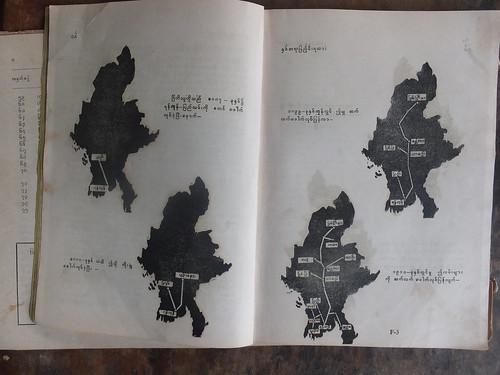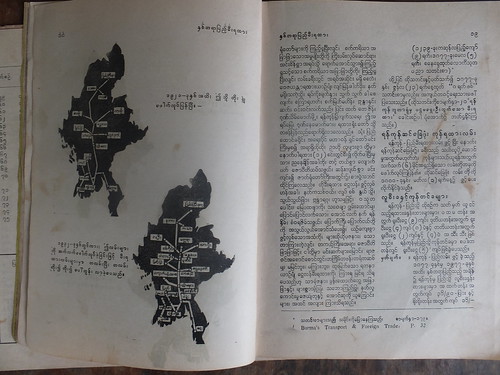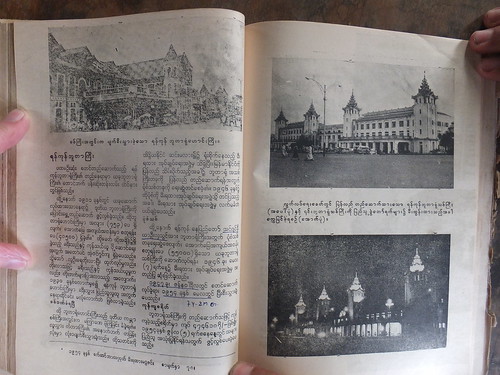It has to be admitted that Myanmar's railways, whilst having a certain charm, are very run-down by western standards - slow, dirty, unreliable. This is true of much of the infrastructure in a country which was, until recently, regarded as a 'pariah state'.
This situation is starting to change - for instance, the Japan International Co-operation Agency (JICA) is heavily involved in the necessary modernisation of the railway system. The JICA website, referring to work in Myanmar, says "a proposed multi-million dollar project will upgrade the maintenance and safety of railroad infrastructure, most of it dating from the pre-World War 11 British colonial era".
In May 2014, JICA held seminars in both Yangon and Naypyidaw to present the proposed Yangon Urban Transport Master Plan. The JICA report on the seminars is here.
Development of Railways in Myanmar
Rail transport was first introduced in Myanmar in May 1877 (when Lower Burma was a British colony) with the opening of the 163-mile (262 km) Yangon to Pyay line by The Irrawaddy Valley State Railway. At Yangon, it terminated at a station at Kyee Myin Daing, now a through station on the Circle Line.
 The impressive station building at Kyee Myin Daing.
The impressive station building at Kyee Myin Daing.
In 1884, the Sittang Valley State Railway opened a 166-mile (267 km) line from Yangon via Bago along the Sittaung River to the town of Taungoo. The Third Anglo-Burmese War of 1885 resulted in the annexation of Upper Burma and by 1889 the British had extended the Taungoo line to the former capital of Upper Burma, Mandalay.
Next, the Mu Valley State Railway began construction of a line from Sagaing (near Mandalay) to Myitkyina, in the north. Mandalay was connected to Shwebo in 1891, to Wuntho in 1893, to Katha in 1895 and to Myitkyina in 1898.
In 1896, the three companies were combined into a state owned public undertaking called the Burma Railway Company (from 1928 called Burma Railways and, in 1989, the name 'Myanma Railways' was adopted.
The railway served the Taninthayi coast in the south from 1907 with the opening of the Bago-Mottama line. Then, passengers had to take a ferry over the Thanlwin River (Salween River) to reach Mawlamyine but a bridge is now provided.
Myanma Railways has planned an ambitious programme to significantly expand the network, as outlined in their presentation here.
 Stages in network development (from book reference [1]).
Stages in network development (from book reference [1]).
 More stages in network development (from book reference [1]).
More stages in network development (from book reference [1]).
Yangon and the Circle Line
Yangon, although no longer the capital of Myanmar (that honour now reposes with Naypyidaw), remains the transport hub of Myanmar. There's no Metro system around Yangon (although an 8 km tram route has opened, as I report here, so public travel around the sprawling city area with its population in excess of 5 million currently relies on battered buses or, until recently, fairly battered and rather slow trains on the busy 30-mile long Circle Line and a network of suburban branches. Refurbished second-hand diesel multiple units cascaded from Japan have now been introduced which provide a significant increase in comfort and, with driver-controlled power-operated doors, enhance safety.

A refurbished second-hand Japanese-built Diesel Multiple Unit on a Circle Line service in 2016.
Yangon Central Station, as its name implies, has a prime location in the city and is always a good place to observe railway operations. The station is on the 30-mile long double track circular railway, logically called the Circle Line. During the day, trains depart from regularly from Yangon Central, making a 3-hour clockwise trip around the Circle Line back to Yangon Central. There is also a regular anti-clockwise service. The Japanese Diesel Multiple Units mentioned above now seem to be operating most of these trains. Other trains only make a partial circuit before returning to Yangon, for instance the Yangon - Insein service which, in 2016 was still locomotive-hauled.
 Left: The original station buildings at Yangon Central Station, damaged in WWII. Right upper: The post-war station in 'Burmese style'. Right lower: The post-war station at night (all from book reference [1]).
Left: The original station buildings at Yangon Central Station, damaged in WWII. Right upper: The post-war station in 'Burmese style'. Right lower: The post-war station at night (all from book reference [1]).
Book references
[1] '100 years of Burma Railways 1877 - 1977' (in Burmese) published by Burma Railways 1977.
Related posts on this site
All my Myanma Railways posts.
Related posts on other sites
Myanma Railways presentation.
Myanmar Railways (Wikipedia).
My Pictures
All my Myanma Railways Pictures.
